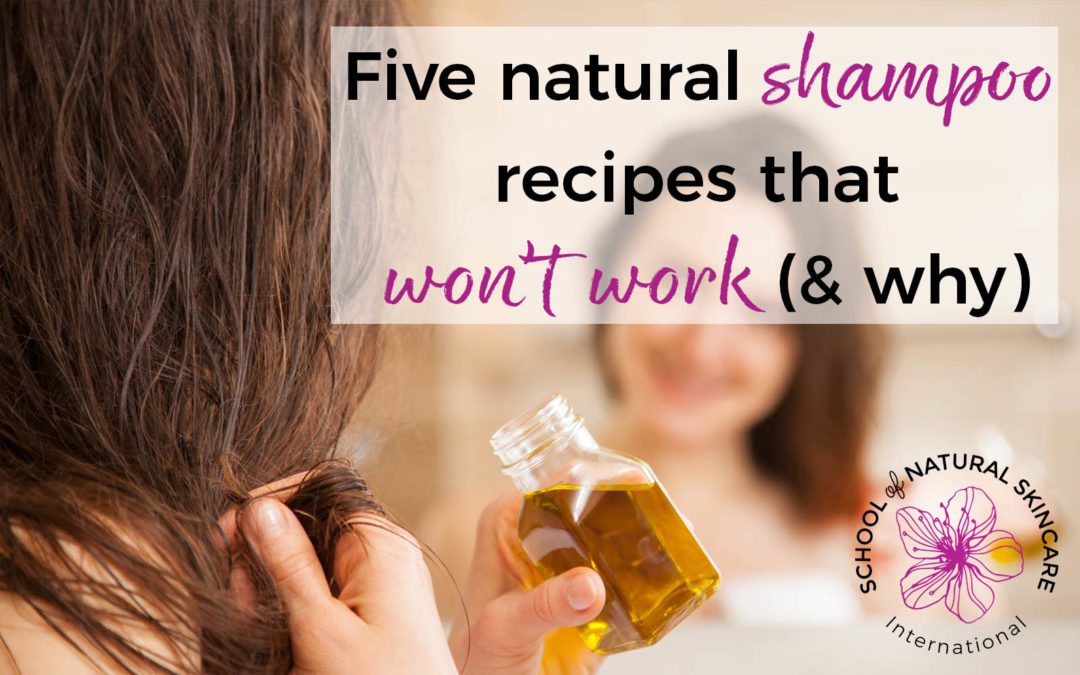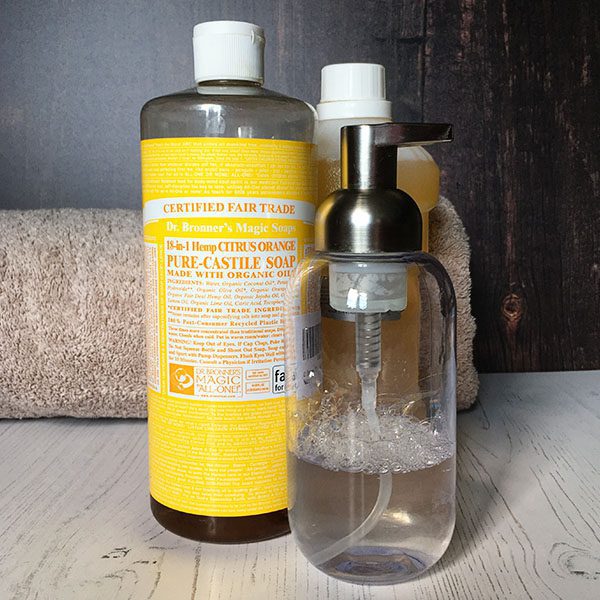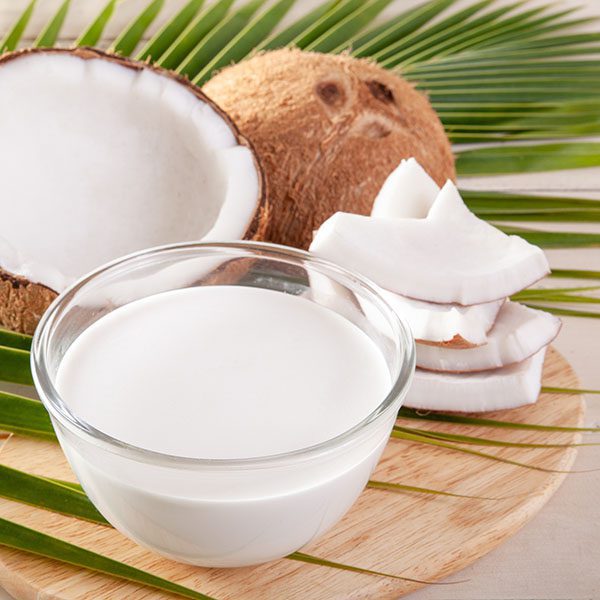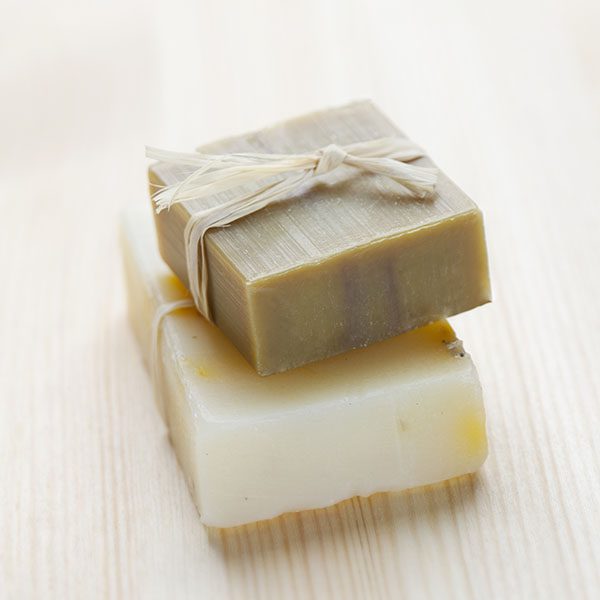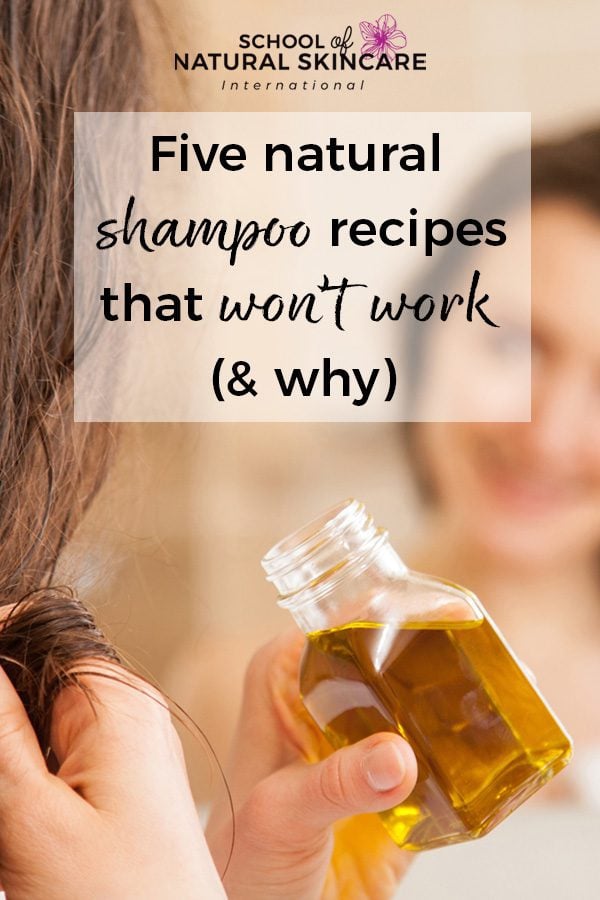DIY shampoo recipes are so popular right now! However, the desire for easy, natural recipes made from ingredients you’ll find in your kitchen, has led to a ton of recipes being shared online that simply won’t work, (and may even do harm to your hair).
This article will explain what’s wrong with the most popular types of DIY shampoo recipe and we’ll share what an effective recipe needs instead.
DIY haircare recipes are commonly based around the following ingredients:
- Castile soap (eg Dr Bronner’s)
- Coconut milk
- Cold process soap bars
- Baking soda
Not only do these recipes not effectively cleanse and protect the hair, (more on that in a minute), there are other dangers associated with using them too. For example, the vast majority of DIY recipes are not preserved or stored correctly, which can lead to bacteria, yeast and mold proliferating in them – potentially leading to skin and eye infections, thrush, toxic shock and atopic dermatitis.
Before we go any further, let’s look at what an effective shampoo should do.
- Cleanse the hair: Shampoo helps to remove dirt and soil from the hair and scalp. Sebum, dust and styling products build up on hair over time, and shampoo is needed to remove them, without being too harsh and removing beneficial lipids on the hair.
- Close the cuticle: The cuticle is the outermost layer of the hair and resembles roof tiles. If the tiles are nicely closed or laid down, they protect the underneath surface. A good shampoo will make sure that cells of the cuticle are laid flat, thus protecting the underneath layers from damage.
- Balance pH of hair: Hair needs a slightly acidic pH in order for the cuticle to be closed down, and to decrease the static electricity which causes tangles and damage to the hair.
When we assess whether natural DIY shampoo recipes are any good, we’ll consider if they’ll help with these three things: cleansing the hair, closing the cuticle and balancing the pH level.
1) Castile soap (eg Dr Bronner’s)
A huge number of DIY Shampoo recipes use Castile soap as their main ingredient, often combined with aloe vera, carrier oils, and/or essential oils. We understand why people think they can use it – it foams, (a little), it cleanses the scalp, it’s easy to get hold of, and it’s naturally derived. It’s a good, basic cleanser for skin. But what about hair?
Is castile soap a suitable shampoo? Does it cleanse the hair, close the cuticle, and balance the pH?
Castile soap will definitely cleanse the hair, so this task is taken care of. But it won’t do the other two tasks – the pH of castile soap is very high (or alkaline – the opposite of acidic), around 9 -10, which is completely unsuitable for hair. When hair is treated with an alkaline product, it will leave the cuticle cells open and prone to damage. Hair with an imbalanced pH will also be a lot more prone to breaking and tangling.
Let’s take a closer look at a recipe we found that uses it:
World’s Simplest Homemade Shampoo (that’s perfect for your hair type).
Ingredients:
About ¾ cup liquid castile soap.
¼ cup aloe vera.
1 tsp jojoba oil.
½ – 1 tsp sweet almond oil (optional for dry hair).
50-60 drops essential oils of your choice (perfect for your hair type).
What’s wrong with this recipe?
In addition to the major issue with castile soap, as explained above, this shampoo has a number of other issues to note:
- It does not contain a preservative – if this mixture is left at room temperature for more than a few days, it is very likely to show microbial growth in it – yikes!
- It mixes oil and water – two ingredients that are incompatible without a emulsifier or solubilizer.
- The recipe suggests that adding essential oils will make it “perfect for your hair type”. While altering the essential oils can change the properties of a product a bit, to really adjust the product for your hair type, much more than changing essential oils is needed. You need to consider which cleansing agents to use and the amount needed, and think about which other nurturing ingredients are suitable for that hair type. Also, which type of shampoo should be formulated in the first place?
- It uses inconsistent and inaccurate measurements. Drops, cups, teaspoons and such are not a correct measurement for safe and effective cosmetic formulations.
2) Coconut milk
Recently there have been an increasing number of shampoo recipes that centre around using coconut milk. It is often combined with other ingredients like honey, vinegar, castile soap and carrier oils.
Is coconut milk a suitable shampoo? Does it cleanse the hair, close the cuticle, balance the pH?
Coconut milk on its own, (without soap added), will not cleanse the hair. So it fails the first task! The pH of coconut milk is close to neutral (around 6.0-7.0), which is too high for the hair. Coconut milk will provide some vitamins and moisturization to the hair, but it won’t close the cuticle or balance the pH of the hair. Long term use of coconut milk ‘shampoo’ can actually result in hair damage.
Let’s take a look at this next DIY recipe we found:
Homemade Coconut Milk Shampoo.
Ingredients:
¼ cup coconut milk (homemade or canned).
1/4 cup liquid castile soap, like Dr. Bronners.
20 drops of essential oils of choice (Peppermint, lavender, rosemary and orange, or a combination of those).
For dry hair, add ½ tsp olive or almond oil (optional).
(The recipe also says you can keep it in the shower for up to a month).
What’s wrong with this recipe?
- It uses coconut milk, which will not cleanse, close the cuticle, or balance the pH.
- It does not contain a preservative.
- The instruction to “keep in the shower for up to a month” is concerning. An unpreserved product containing fresh ingredients like homemade coconut milk, kept in a warm, humid environment is a recipe for disaster, as coconut milk is full of (yummy) nutrients for microbes!
- As with the previous shampoo recipe, it uses inconsistent and inaccurate measurements.
Here is another example of an online recipe with problematic areas.
Moisturizing DIY pH Balanced Shampoo.
Ingredients:
1 can full fat coconut milk (about 13.5 oz) – ph 6.1-7.0
2 tbsp liquid raw honey – ph 3.9
1 tsp jojoba oil – ph 4.21
1 tsp castor oil – ph 4.65
2 tbsp apple cider vinegar – ph 3.1
1 tsp essential oils of choice (lavender, cedarwood, rosemary, peppermint, carrot, clary sage and tea tree are all good for hair).
This recipe actually has a fairly good pH level that will benefit the hair, but it has so many other things wrong with it!
- As we mentioned above, coconut milk will not cleanse the hair.
- It doesn’t contain a preservative. With ingredients like honey and coconut milk, this is pure heaven for bacteria, yeast and mold to grow.
- It contains no surfactant or emulsifier to mix the added oils with water, and will therefore leave your hair feeling (and looking) rather oily after using it.
3) Shampoo soap bars
Many DIY recipes are for ‘solid shampoo bars’, which on closer inspection are actually cold process soap bars. ‘Soaping’ is certainly a popular (and addictive!) hobby for many. Homemade cold process soap can be wonderful for your skin. But is it any good for hair?
Are soap bars a suitable shampoo? Do they cleanse the hair, close the cuticle, balance the pH?
Soap bars are very similar to liquid castile soap, but they have a solid form. The chemistry behind these two products is the same and they both have a pH which is way too high for the hair. Soap bars will clean the hair effectively, but since they won’t close the cuticle down, or balance the pH of the hair, it will leave the hair dry, tangled and prone to further damage.
Here’s an example of an online homemade solid shampoo bar recipe:
Ingredients:
10 oz coconut oil
10 oz tallow (or palm oil)
10 oz olive oil
6 oz castor oil
5 oz lye
12 oz distilled water
1.5 oz essential oils added at trace (0.5 oz each of tea tree, rosemary and peppermint)
This is actually a nice recipe for cold process soap, which will make a good soap bar to be used on hands and body, but not on the hair!
4) Baking soda
Another popular category of DIY shampoo uses baking soda as the key ingredient. It’s easy to get hold of, (you probably already have some), and it’s inexpensive. But is baking soda a suitable shampoo? Does it cleanse the hair, close the cuticle, balance the pH?
Baking soda can act as a degreaser, so it will remove some of the oils from the hair, but it won’t do it very gently. A solution of baking soda in water has a very high pH, (about 9.5), which is too high for the hair, and can irritate your scalp. It will not close the cuticle, and will eventually leave your hair brittle and prone to breakage.
We found these instructions for a baking soda shampoo:
“Start by mixing 1 part baking soda with 3 parts water. I have shoulder length hair and mix about 2 to 3 tablespoon of baking soda with 3 times that amount of water in a small squeeze bottle. You can adjust this depending on your hair length. Apply the baking soda and water mixture to dry or wet hair by starting at the roots and working to the ends. Let it sit for 1 – 3 minutes, then rinse with warm water.”
As mentioned above, this approach may offer some degreasing, but will also cause damage to the hair. So it is not a good option for a natural shampoo.
How to make an effective natural DIY shampoo
So as you can see, castile soap, coconut milk, cold process soap and baking soda are not good choices for your DIY shampoo.
So what is?
True shampoos that cleanse, close the cuticle and balance the pH, feature one key ingredient type that is missing from all of these DIY recipes.
That ingredient type is surfactants, which are a major group of ingredients, and are not as technical or intimidating as they may sound!
In fact, they can be derived from natural sources such as coconut, sugar and even apples, and many are approved for use in certified organic products. They make wonderful shampoos that are natural, gentle and effective.
We will divulge more about this in our next article! And we’ll explain in a straightforward and easy to understand way, just how a shampoo works, the key ingredients to include and why.
Make sure you sign up for our FREE ‘Become a Natural Haircare Formulator’ series, so you don’t miss out!
We’ll be sending you an awesome series of articles, and running a challenge to help you formulate your own natural or organic shampoo! Plus, you’ll get access to an exclusive special offer on our newest course being released soon.
Get your free Natural Shampoo & Conditioner Recipe Book
Learn to make your own natural shampoos & conditioners with luxurious natural ingredients.
Download this fabulous book and discover recipes for:
- Cocoa Butter and Patchouli Solid Shampoo Bar
- Shea and Coconut Conditioner for Dry Hair
- Monoi Beauty Butter for Hair
- Vanilla and Benzoin Solid Conditioner Bar
- Gentle Aloe and Chamomile Liquid Shampoo for normal hair
Plus we’ll share with you:
- The primary function of shampoos and conditioners and how they work
- A handy video where Gail shows you the equipment that you’ll need
- A list of recommended suppliers in the UK, USA and Australia
- Tips on customizing for different hair types
- 7 powerful ingredients to personalize your haircare products
Love this blog post? Save this image below on Pinterest so you can be sure to remember!
Sources:
Microbiological Profile of Selected Cosmetic Products with and without Preservatives after Use
DAVID W. ANDERSON, JR., Ph.D.,* and MARION AYERS, B.A.
Contamination of Emollient Creams and Ointments with Staphylococcus aureus in Children with Atopic Dermatitis
Carr, J.1; Akram, M.; Sultan, A.; Hunter, L.; Moustafa, M.; Messenger, A.; Fenton, P.; Cork, M. J.
Recipe links:
http://www.naturallivingideas.com/homemade-shampoo-for-every-hair-type/
https://wellnessmama.com/3701/homemade-shampoo/
https://pronounceskincare.com/moisturizing-diy-ph-balanced-shampoo/
https://wellnessmama.com/26682/shampoo-bar-recipe/
https://www.mindbodygreen.com/0-8953/diy-this-baking-soda-shampoo-saved-my-hair.html

